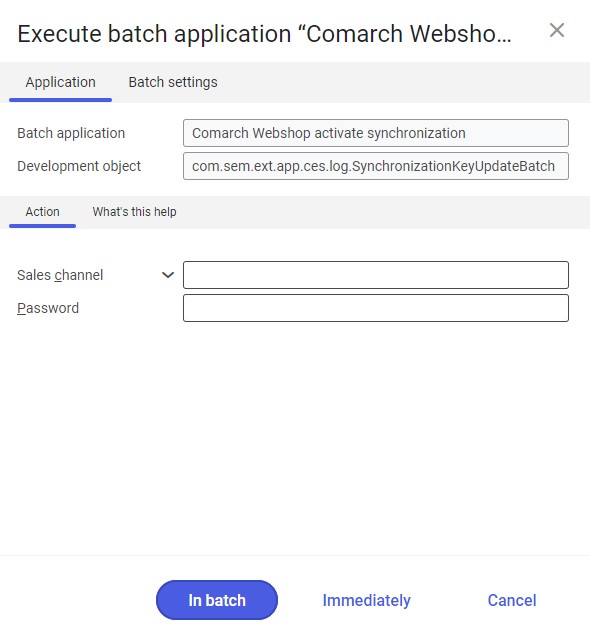Extensions to the Sales channels application, belonging to the Multi-channel sales framework, make it possible to handle adapters, including the Comarch ERP Webshop adapter. Using this adapter, it is possible to exchange data with Comarch Webshop online stores through features available in the Multi-channel sales framework.
Work pane
The Comarch Webshop extension to the work pane of the Sales channels application provides an additional tab Comarch Webshop, containing settings that pertain to a sales channel selected in the application header. Available fields include:

- Webshop URL (required) – in this field, it is necessary to enter the copied URL address of a Comarch Webshop store to be integrated with the ERP system
- Webshop Name (required) – in this field, it is necessary to enter the name of a Comarch Webshop store to be integrated with the ERP system
- Company name (required) – in this field, it is necessary to enter the name of a Comarch Webshop company to be integrated with the ERP system
- Comarch Webshop version (required) – using the field’s drop-down list, it is necessary to select a Comarch Webshop protocol through which connection will be made
- Manufacturers item categories – it allows the optional selection (with the use of the [Value assistant button]) of a sales channel item category to be used for assigning items to their manufacturers
- Brands item categories – it allows the optional selection (with the use of the [Value assistant] button) of a sales channel item category to be used for assigning items to their brands
- Old price – Customer price classification (required) – after a classification is entered in this field, both the curent and previous, crossed-out prices are displayed to customers in the external system. Classifications may be created and retrieved from the Classifications application.
- Localization (required field) – in this field, it is necessary to enter the localization of Comarch Webshop. A relevant value may be selected from a drop-down list.
- Individual price list setting – for the purposes of customers with individual price lists, this setting allows managing the visibility of prices and items not included in those price lists. Available options include:
- Show standard price – a standard price available to all customers will be displayed to a customer with an individual price list
- Hide item – a given item will not be displayed to such a customer
- Ask for price – an Ask about price notification will be displayed next to a given item
- Group of customizable attributes – it allows adding items with a text field to the sales channel; customers will be able to enter their comments or notes in such a field when purchasing a given item. Notes added in Comarch Webshop can be imported into the ERP system together with sales orders. In this field, it is necessary to enter the ID of a PIM item characteristic group, entered also in the Sales channels application’s Group identifier field on the PIM – Item characteristic groups and Group identifier column of a selected item characteristic row on the PIM – Item characteristic setting tab. A given characteristic must be of the Text category. Additionally, an item to which text fields are to be added, must be assigned to the same characteristic in the Item characteristics application.
Additional settings
In order to perform the first synchronization of a sales channel using the Comarch ERP Webshop adapter, it is necessary to run the batch application Comarch Webshop activate synchronization.
To connect a newly created sales channel with a Comarch Webshop store, the user should enter in the application the sales channel’s name and a password available on the website of the Comarch Webshop administrator in the Synchronization Data section; next, it is necessary to select the [In batch] button.

